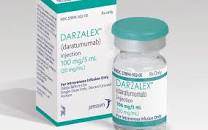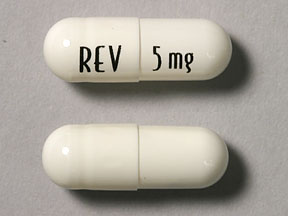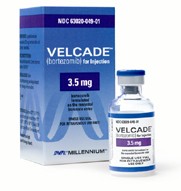
Recently Diagnosed or Relapsed? Stop Looking For a Miracle Cure, and Use Evidence-Based Therapies To Enhance Your Treatment and Prolong Your Remission
Multiple Myeloma an incurable disease, but I have spent the last 25 years in remission using a blend of conventional oncology and evidence-based nutrition, supplementation, and lifestyle therapies from peer-reviewed studies that your oncologist probably hasn't told you about.
Click the orange button to the right to learn more about what you can start doing today.
- You are here:
- Home »
- Blog »
- Multiple Myeloma »
- Darzelex + VRd @ Induction Increases sCR, MRD for Multiple Myeloma-
Darzelex + VRd @ Induction Increases sCR, MRD for Multiple Myeloma-
“…Darzalex in combination with Revlimid,Velcade and dexamethasone, (VRd), demonstrated a higher percentage of stringent complete response (sCR) among transplant eligible, newly diagnosed patients with multiple myeloma”
According to the studies linked and excerpted below, adding Darzelex (daratumumab) to the standard-of-care induction triplet VRd increases the number of multiple myeloma patients who achieve stringent complete response (sCR) and minimal residual disease (MDR).
The first question for newly diagnosed MM patients is if the addition of Darzalex increases short, long-term and late stage adverse events.
The second question newly diagnosed MM patients should ask is will reaching sCR or MRD lead to a longer overall survival? Overall survival meaning overal length of life, not PFS or the length of first remission.
But the real question newly diagnosed MM patients considering this quadruplet chemo regimen is if, by reaching minimal residual disease (negative) status, can you can postpone or not undergo an autologous stem cell transplant?
In other words, according to the second linked article below, does achieving MRD negativity negate the need for an autologous stem cell transplant and all of the toxic damage that can accompany it?
Unfortunately, MRD as a diagnostic marker is still relatively inconsistent to use for all MM patients everywhere. But the issue is out there. The possibility is there.
Have you been diagnosed with multiple myeloma? Are you eligible for an ASCT but question the need? Scroll down the page, post a question or comment and I will reply to you ASAP.
Thank you,
David Emerson
- MM Survivor
- MM Cancer Coach
- Director PeopleBeatingCancer
Recommended Reading:
- Myeloma Caregivers Need SUPPORT!
- Myeloma Cancer Coaching- MRD Status- Bisphosphonate Therapy
- Minimal Residual Disease (MRD) in Multiple Myeloma
Addition of Darzalex to Chemotherapy Shows Promise in Myeloma
“The combination use of Darzalex (daratumumab) in combination with Revlimid (lenalidomide), Velcade (bortezomib) and Ozurdex (dexamethasone), also known as VRd, demonstrated a higher percentage of stringent complete responses among transplant eligible, newly diagnosed patients with multiple myeloma, according to topline results from the phase 2 GRIFFIN study.
“The data from the phase 2 GRIFFIN trial underlines the potential of daratumumab when used in combination with VRd and supports Janssen’s decision to start the PERSEUS and CEPHEUS phase 3 studies of daratumumab in combination with VRd for certain frontline multiple myeloma indications…”
The randomized, open label, parallel assignment trial, which included 223 patients with newly diagnosed multiple myeloma who were eligible for high-dose chemotherapy and autologous stem cell treatment, met its primary endpoint of a higher rate of stringent complete response compared with VRd alone (42.4% vs. 32.0%).
Secondary endpoints, including the results of the minimal residual disease analysis, supported the primary endpoint backing the use of Darzalex in combination with VRd…
Overall, the safety profile of Darzalex used in combination with VRd was consistent with the safety profile for each separate therapy, which has been reported from previous studies.
“This data also builds on the efficacy and safety data for daratumumab as a frontline treatment for transplant eligible multiple myeloma patients as seen in the CASSIOPEIA phase 3 study in which newly diagnosed patients with multiple myeloma who were candidates for (autologous stem cell transplantation) were treated with daratumumab combined with an immune-modulatory drug and a proteasome inhibitor,” van de Winkel added.
Should minimal residual disease negativity be the end point of myeloma therapy?
“…Indeed a three- to fourfold prolongation in OS in MM24 is related not only to the increased extent, frequency, and duration of response to initial therapy, but also to the high rates of durable responses even in relapsed MM…
Until recently, MRD negativity was obtainable primarily in the context of allogeneic stem cell transplantation, where sustained MRD negativity due to a donor graft-versus-MM effect is associated with long-term disease-free survival and cure.29–31 However, it is now urgent to define and incorporate MRD into our response criteria more generally, since combination novel therapies, with or without autologous stem cell transplant (ASCT), can now achieve MRD…
In addition to these meta-analyses supporting the clinical utility of MRD for predicting outcome in MM, there are also multiple ongoing DFCI/IFM, Compass, Black Swan, industry-sponsored, and cooperative group trials that will provide additional clinically annotated data to further bolster this database. These studies will provide the framework for incorporation of MRD into clinical trials to determine whether achieving MRD status utilizing different therapies, at various stages of MM, or in genetically distinct MM subgroups has similar clinical implications…
Most importantly, our ability with modern therapies to achieve an unprecedented frequency and extent of response in MM, including MRD negativity, now provides the realistic framework for long-term survival and potential cure in MM.”




